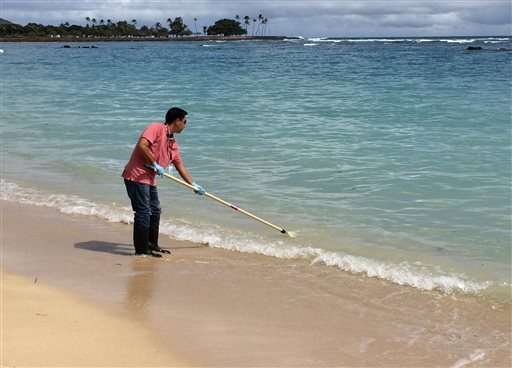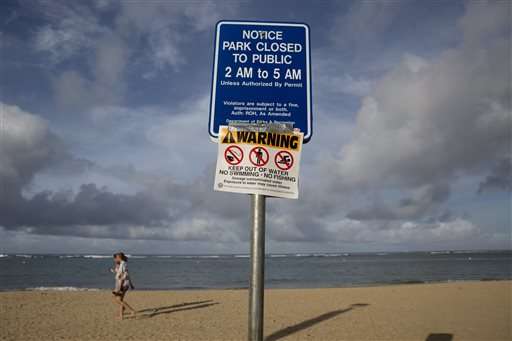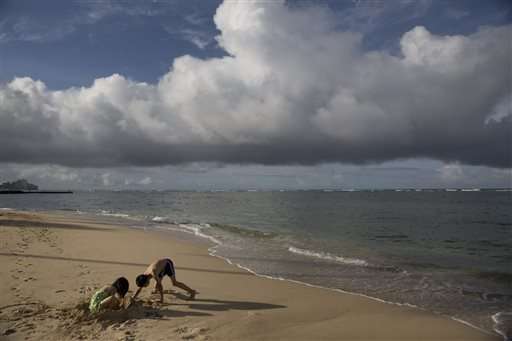Waikiki water tested for bacteria after sewage spill

Hawaii's white sand beaches in Waikiki were mostly deserted after officials warned the public about a half-million-gallon sewage spill in Ala Moana Beach Park, which is adjacent to the world-famous tourist destination.
Heavy rain associated with Tropical Storm Kilo caused manhole covers in Honolulu to overflow with sewage and the Honolulu Zoo to flood on Monday, prompting officials to close an area of beach including Waikiki.
The Department of Health is testing a 4-mile stretch of waterfront from Kapahulu Avenue in Waikiki to Point Panic in Kakaako. Sewage came out of manholes at Ala Moana Beach Park, on a street fronting a shopping mall at the edge of Waikiki where there's two pumping stations.
Keith Kawaoka, Hawaii state Department of Health deputy director for environmental health, said at a news conference Tuesday: "It depends where the tidal flow is. It depends on the high tide, low tide situation, where the currents are flowing. That's why we're doing sampling in over 20 areas from Kakaako to Diamond Head to determine where the extent the sewage might have flowed to."
Still, dozens of visitors waded into the water, and young parents carried their toddlers into the ocean, ignoring the warning signs about unsafe water.
Carmen Antaky went swimming in Waikiki with her friend Sloan Hill-Lindsay on Tuesday. "I guess a lot of people are freaked out about it. We still jumped in," Antaky said.
They said they go in the water every day and were willing to take their chances. "We're also from LA, where it's pretty polluted anyways," Hill-Lindsay added.
Officials said Tuesday the Waikiki Beach area was not closed because of the nearby sewage spill. Rather, they said the area was closed out of an "abundance of caution," and because water from the flooded zoo flowed directly into storm drains, which is not treated before entering ocean waters.

"Would you rather swim with human feces or possibly with animal feces," said Shayne Enright, a spokeswoman for the city's Department of Emergency Services.
There was a statewide brown water advisory issued that recommended people stay out of all ocean waters, but the only beaches to be fully closed with posted signs and lifeguard warnings were from just west of the sewage spill site east to the end of Waikiki beach, where the zoo is located.
There are two pumping stations in the area where the spill occurred, but a key part serving one of them was missing because of construction when the storm hit, said Lori Kahikina, Honolulu's director of environmental services, on Tuesday.
Kahikina expressed regret that various city departments hadn't better communicated to ensure both pumping station were operational.
Officials had said Monday that debris was clogging storm drains and there reports that people were opening manhole covers to let the storm water drain into the sewage system, even though sewage pipes and pumps aren't designed to handle that volume of liquid.
Peter Parhar, from Vancouver, British Columbia, who was also on a Waikiki beach Tuesday, said the infrastructure should be improved and he was concerned about the city's communication of the issue.
"More should be done to inform the beach patrons of the risks of being in the water," Parhar said. "For the tourist segment that isn't English-speaking, they have no idea what's going on and they're carrying little infants into the water."

Waikiki was not the only area of Oahu that was affected by an overflow of wastewater. The state Department of Environmental Services said that Kailua, Kaneohe and Kalanianaole Highway in Aina Hina also experienced overflowing sewer systems. The Department of Health issued warnings for people to stay out of the water in all affected areas, including Kaneohe and Mamala bays, though no signs were posted.
In 2006, the city temporarily closed Waikiki's beaches after 48 million gallons of raw sewage poured into the Ala Wai Canal bordering the area's hotels and condominiums. That spill occurred after a sewage line ruptured following weeks of heavy rains, forcing the city to divert wastewater into the canal.
The entire state remained under a flash-flood watch again Tuesday, with more rain expected. This year's hurricane season, which lasts through the end of November, has been particularly active.
A new tropical storm, Ignacio, formed east of the Hawaiian Islands on Tuesday and is forecast to become a hurricane by Thursday, Central Pacific Hurricane Center Meteorologist Chevy Chevalier said. "It's an above-average year already, and we're still just in August," he added.
There have been 17 storms so far this year in the Pacific, 12 of which reached hurricane status, according to the National Weather Service. Six of those storms reached super-typhoon status, which means they had maximum sustained winds over 150 mph.
Although it's too early to predict, Ignacio's current path could take it near or over the islands, Chevalier said.
"The reason for the forecast of an above average tropical season in the Pacific this year is El Nino conditions," Chevalier said in an email. "El Nino typically brings this area above normal sea surface temperatures and less vertical wind shear, both of which normally lead to tropical cyclone intensification."
© 2015 The Associated Press. All rights reserved.



















